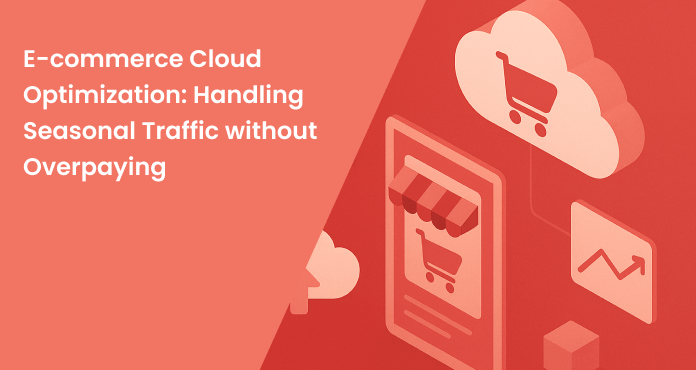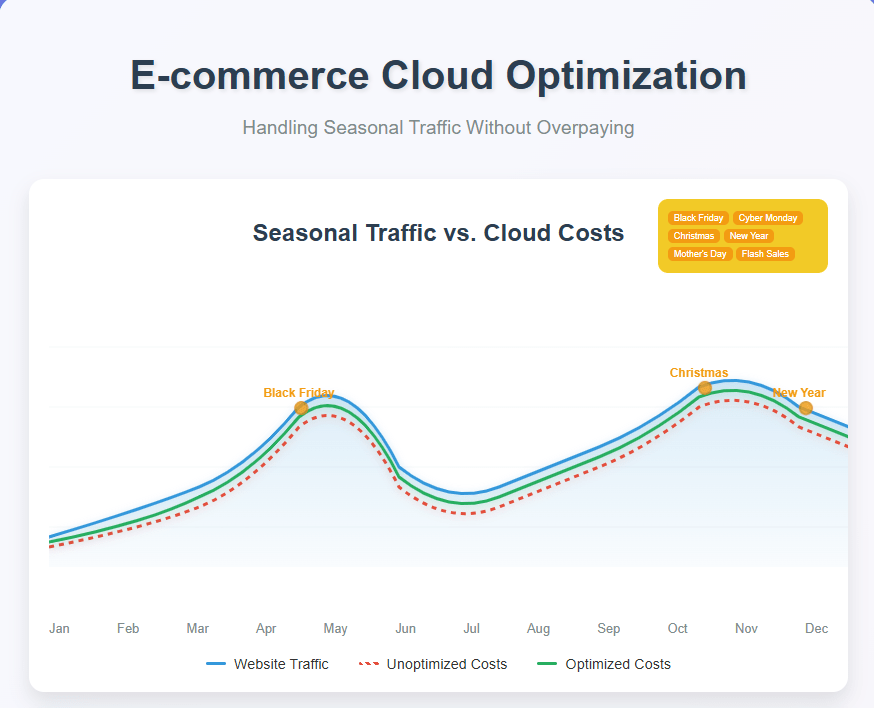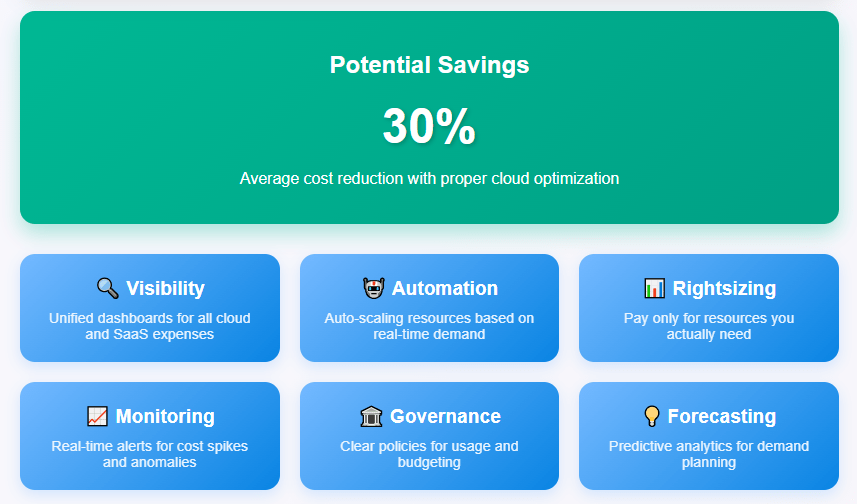
In the world of e-commerce, the cloud has become an indispensable asset. It empowers businesses to scale rapidly, accommodate fluctuating demand, and innovate at a speed that would be unimaginable with traditional on-premises solutions. But this flexibility can come at a cost—especially when seasonal traffic spikes threaten to balloon your cloud bills. As Black Friday, Cyber Monday, holiday sales, or even surprise viral trends hit your site, how can you handle the influx of traffic without overpaying for cloud resources?
In this article, we’ll explore best practices, tools, and strategies to help e-commerce companies optimize their cloud usage for seasonal surges, avoid unnecessary expenses, and maintain stellar customer experiences. We’ll also demonstrate how Binadox, a leading cloud and SaaS cost management platform, can be an essential partner in this journey.
Understanding the E-commerce Cloud Dilemma
The Promise—and the Peril—of Cloud for E-commerce
The migration of e-commerce platforms to the cloud has unlocked unprecedented flexibility. Cloud hosting offers the ability to:
- Scale resources dynamically based on real-time demand
- Pay-as-you-go instead of over-investing in on-premise infrastructure
- Deploy sites and microservices globally for fast customer experiences
However, with great flexibility comes great financial responsibility. The very features that make the cloud appealing—auto-scaling, pay-per-use, instant provisioning—can also lead to runaway costs when not managed vigilantly, particularly during seasonal peaks.
The Seasonal Traffic Challenge
Most e-commerce businesses do not see steady, predictable traffic year-round. Instead, their web traffic graph looks like a series of rolling hills punctuated by dramatic peaks. These spikes might occur during:
- Black Friday/Cyber Monday
- Christmas and New Year holidays
- Mother’s Day, Singles’ Day, or other regional shopping festivals
- Flash sales or product launches
During these times, customer expectations are sky-high. A slow or unavailable website can mean millions in lost sales, not to mention damage to brand reputation. The instinctive (and costly) reaction is to overprovision cloud resources “just in case,” but that means overpaying during all the quiet months.
So how can you get the best of both worlds—elasticity for traffic surges, and cost-efficiency when things are calm?

Cloud Cost Optimization Fundamentals
Before diving into seasonal strategies, let’s revisit the core principles of cloud cost optimization for e-commerce:
- Visibility – Know what you’re using, how much, and why.
- Automation – Use the cloud’s own tools to scale up and down as needed.
- Rightsizing – Only pay for the resources and features you actually need.
- Continuous Monitoring – Stay on top of cost spikes and anomalies.
- Governance – Set clear policies for usage, procurement, and budgeting.
These fundamentals are as relevant to daily operations as they are to high-traffic events. However, the stakes are much higher during seasonal peaks—so your strategy needs to be more proactive.
Step 1: Achieving Cloud Visibility and Accountability
The first step in controlling costs during traffic surges is full visibility across your cloud infrastructure and SaaS stack. Without this, you’re essentially flying blind: unaware of unused resources, overlapping services, or stealthy “cloud creep.”
Unified Dashboards
Platforms like Binadox offer centralized dashboards that give e-commerce businesses a real-time, holistic view of all cloud and SaaS expenditures. Instead of logging into different vendor portals (AWS, Azure, Google Cloud, Shopify plugins, email marketing SaaS, etc.), you see everything in one place. This visibility makes it possible to:
- Pinpoint which applications and services are driving costs during peak periods
- Detect anomalies—such as a sudden jump in bandwidth or storage
- Break down spend by team, product, or marketing campaign
Cost Allocation and Tagging
Use cloud tagging and cost allocation features to assign resources to specific business units, teams, or campaigns. This not only aids in reporting but also creates accountability. With tagging, you can quickly identify if a surge in costs is due to a particular marketing initiative or region, enabling smarter business decisions.
Step 2: Proactive Resource Planning for Seasonal Peaks
Predictive Analytics and Forecasting
Historical data is your friend. By analyzing previous years’ traffic and resource consumption, you can:
- Forecast likely demand for upcoming peak periods
- Set budget alerts based on anticipated increases
- Preemptively adjust scaling rules or reserve capacity
Tools like Binadox help automate this process, providing predictive analytics that turn raw data into actionable insights.
Automation: Scaling Up and Down
Modern cloud platforms (AWS Auto Scaling Groups, Azure VM Scale Sets, Google Cloud Managed Instance Groups) allow for automated scaling. The key is to set smart rules:
- Scale up as user demand increases—adding more compute power, memory, or bandwidth.
- Scale down when demand drops—to avoid paying for idle resources.
Tip:
Don’t just focus on “up.” Many organizations forget to automate the scale-down process, resulting in overprovisioned environments long after the peak has passed.
Step 3: Rightsizing—Don’t Pay for What You Don’t Need
Overprovisioning is the enemy of cost efficiency. It’s tempting to double your capacity “just in case” before a sale, but this leads to significant waste.
Instance Rightsizing
Most cloud providers offer a dizzying array of instance types. By analyzing workload patterns, you can:
- Identify underutilized servers or containers
- Switch to smaller, more efficient instance types
- Shut down or pause non-essential workloads during quiet periods
Platforms like Binadox provide rightsizing recommendations tailored to your usage patterns. These data-driven suggestions help you maintain performance during peaks—without overpaying the rest of the year.
Spot Instances and Reserved Capacity
- Spot instances (or preemptible VMs) can provide significant savings for non-critical workloads. Use them for batch jobs, image processing, or backend analytics that can tolerate interruptions.
- Reserved instances (RIs) or Savings Plans lock in lower rates for baseline capacity you know you’ll always need—ideal for core databases or always-on services.
Step 4: Real-Time Monitoring and Alerts
Seasonal spikes are often unpredictable. Viral trends or marketing campaigns can send traffic surging in ways you didn’t plan for. This is why real-time monitoring and alerting is critical.
Automated Alerts
Set up alerts for:
- Unusual cost spikes
- Resource usage exceeding thresholds
- Unexpected new services being provisioned
This enables you to react instantly—before small overruns become big, expensive problems.
Step 5: SaaS Spend Optimization
E-commerce businesses often rely on a constellation of SaaS products for everything from CRM and email marketing to inventory and analytics. These tools, like cloud infrastructure, can contribute to rising costs during peak seasons.
Centralize SaaS Spend Management
- Discover all SaaS subscriptions—including those purchased by individual teams or departments
- Consolidate billing and renewal dates to avoid surprises
- Identify underutilized or duplicate subscriptions
Binadox’s SaaS management tools give you the same level of cost control for your software stack as for your cloud infrastructure.
Step 6: Governance—Policies, Budgets, and Accountability
Optimization isn’t a “set it and forget it” exercise. Strong governance ensures your cost-saving practices endure, even as your e-commerce business grows and evolves.
Policies and Automation
- Set procurement policies for new cloud and SaaS purchases
- Use automation to enforce tagging, budget thresholds, and scaling policies
- Regularly review resource usage and spend against business goals
Involve the Whole Organization
Finance, IT, DevOps, and business leaders all have a stake in controlling costs. Platforms like Binadox enable collaboration, giving every stakeholder access to the data and insights they need.
Step 7: Cloud Optimization as a Competitive Advantage
Why does all of this matter? Because cost optimization is not just about saving money—it’s about enabling growth, agility, and better customer experiences.
- Faster performance during surges means more sales, better reviews, and higher customer retention
- Savings can be reinvested into marketing, product development, or customer support
- Agility enables you to experiment with new channels or markets, knowing you won’t be caught off guard by surprise bills

Binadox: Your Partner in E-commerce Cloud Optimization
Let’s connect the dots—how can Binadox specifically help e-commerce businesses master seasonal traffic without overpaying?
1. Unified Spend Management
See all your cloud and SaaS costs in one dashboard. Filter by team, application, geography, or campaign. Drill down into the specifics of any cost spike with a few clicks.
2. Rightsizing and Optimization Recommendations
Get actionable, data-driven suggestions for rightsizing instances, shutting down idle resources, and consolidating underutilized SaaS subscriptions
3. Automated Alerts and Anomaly Detection
Set custom rules and receive alerts when costs deviate from expected patterns. Proactively stop overruns before they become a problem.
4. Renewal Calendar and License Management
Avoid SaaS renewal surprises. Binadox’s renewal calendar and license manager let you manage upcoming contract renewals, negotiate bulk discounts, and eliminate unused licenses.
5. Integration with Leading Cloud and SaaS Providers
Binadox integrates seamlessly with AWS, Azure, GCP, and over 40 popular SaaS applications, providing instant visibility and optimization opportunities across your entire tech stack.
Try Binadox’s unified cloud and SaaS cost management platform to see how you can save 30% or more—while scaling confidently through every seasonal surge.
Conclusion: Optimization is the New Black (Friday)
Seasonal traffic spikes don’t have to spell budget disaster for e-commerce businesses. With the right tools, policies, and practices, you can handle surges without overpaying—delivering seamless experiences to your customers and maximizing profitability.
Cloud cost optimization is not a one-time event but an ongoing journey. Visibility, automation, rightsizing, and governance should be embedded in your organization’s culture. Platforms like Binadox empower you to take charge of your cloud and SaaS costs, making every shopping season a win for both your customers and your bottom line.

